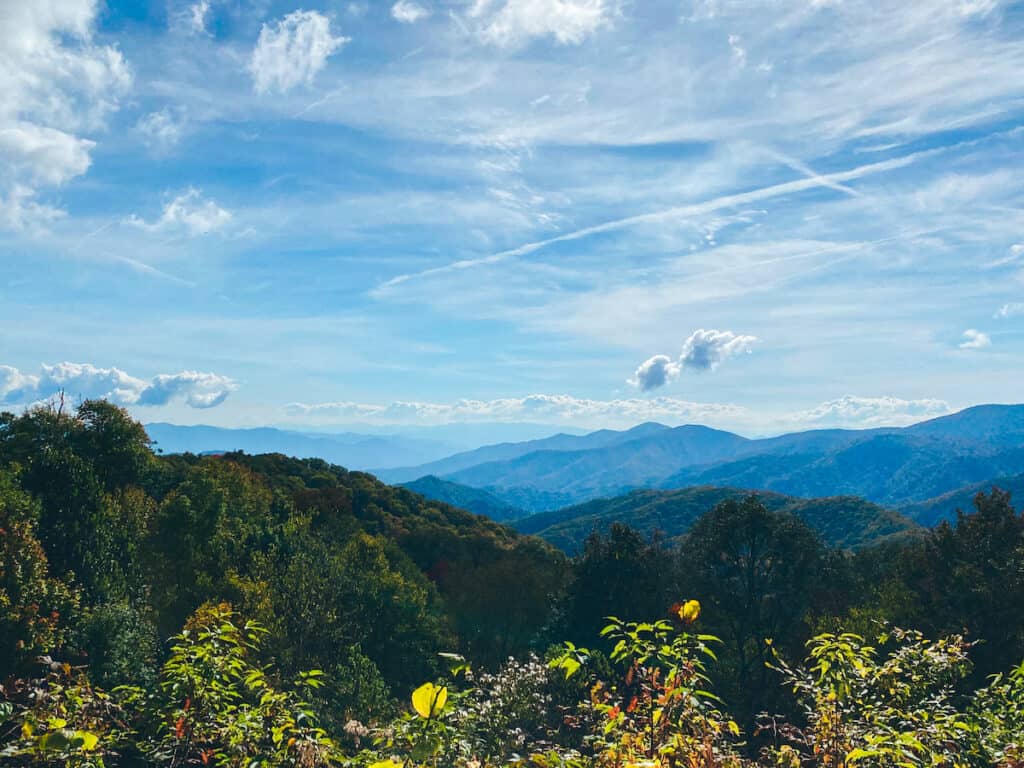
Great Smoky Mountains National Park is famous for its rolling mountains, lush waterfalls, and that classic “smoky” mountain haze. There are hundreds of miles of epic hiking trails, dozens of waterfalls, and miles of scenic drives. With so much to do, planning the perfect 2 days in the Smoky Mountains can feel pretty overwhelming!
While I usually prefer the dramatic western National Parks, after visiting the Smoky Mountains 3 times, I have to say the deep forests and endless rolling mountains of this park have definitely grown on me!
To help plan your ultimate trip, I put together this 2 day Great Smoky Mountains trip itinerary. This guide is perfect for first time visitors, and ensures that you don’t miss out on the highlights of the most visited National Park, even if you only have 1 weekend.
From the iconic views of Clingmans Dome, exploring the history of Cades Cove, to hiking iconic trails like Mount LeConte or Laurel Falls, your two days in the Great Smoky Mountains will be nothing short of epic.
Disclosure: This post contains some affiliate links, which means if you buy something, my blog will receive a small commission at no extra cost to you. I will never recommend products or links on this blog that I have not personally used or fully endorse.
A Quick Look at Your 2 Day Great Smoky Mountains Itinerary
On Day 1 of your Great Smoky Mountains Itinerary, you’ll see:
- Alum Cave Trail
- Drive Newfound Gap Road
- Oconaluftee Visitor’s Center and Mountain Farm Museum
- Optional: Andrews Bald
- Clingmans Dome
On Day 2 of your Great Smoky Mountains Itinerary, you’ll see:
- Cades Cove Loop Road
- Laurel Falls

Important Things to Know About Great Smoky Mountains National Park
Before planning your 2 day itinerary to the Smoky Mountains, there are a few important things you need to know.
Where is Great Smoky Mountains National Park?
Great Smoky Mountains National Park is located in both states of Tennessee and North Carolina, in the Southeastern area of the United States. The nearest towns to Great Smoky Mountains are Gatlinburg and Pigeon Forge, Tennessee and Cherokee, North Carolina.
The Great Smoky Mountains, or “the Smokies” are part of the Blue Ridge mountains, which is a subsection of the greater Appalachian Mountain chain. The Appalachians are thought to be one of the oldest mountain ranges in the world.
How to Get to Great Smoky Mountains National Park
There are no shuttles around Great Smoky Mountains, so you’ll want to fly into one of the closest airports to the Great Smoky Mountains, rent a car, and drive to the Park.
The nearest airport to Gatlinburg, Tennessee (Sugarlands Entrance) is Knoxville McGhee Tyson Airport. The nearest airport to Cherokee, North Carolina (Oconaluftee Entrance) is Asheville Regional Airport, in Asheville, North Carolina.
>> Click here to book your flight to Knoxville McGhee Tyson Airport
>> Click here to book your flight to Asheville Regional Airport
The nearest international airport to Great Smoky Mountains is Greenville-Spartanburg International Airport in Greenville, South Carolina.
>> Click here to book your flight to Greenville-Spartanburg International Airport
This map shows the major highways, towns, and interstates near Great Smoky Mountains.

Does Great Smoky Mountains charge an Entrance Fee?
There is no entrance fee to visit Great Smoky Mountains National Park.
The park was chartered in 1934 and dedicated by President Franklin Roosevelt in 1940. Before the Park’s creation, much of the Smokies was privately owned. When the states of Tennessee and North Carolina transferred the land to federal control, Tennessee mandated that the main roadway through the park, Newfound Gap Road (US 441), must stay toll-free. As a result, there is no charge to enter Great Smoky Mountains.
But, you DO have to pay for parking, starting in 2023. Beginning March 1, 2023 Great Smoky Mountains National Park will require all visitors to purchase and display a “Parking Tag” while parking inside the National Park.
All visitors who park for more than 15 minutes in Great Smoky Mountains, including at trailheads, scenic points, Visitor Centers, ect. must purchase and display a paid Parking Tag. One Parking Tag is required per vehicle.
Parking Tag fees are $5 per day, $15 per week, and $40 annually.
Parking Tag sales are not limited or capped, meaning you do not need advanced reservations to enter the Park. Parking tags do NOT guarantee a parking spot, so be sure to arrive early to trailheads and popular spots!
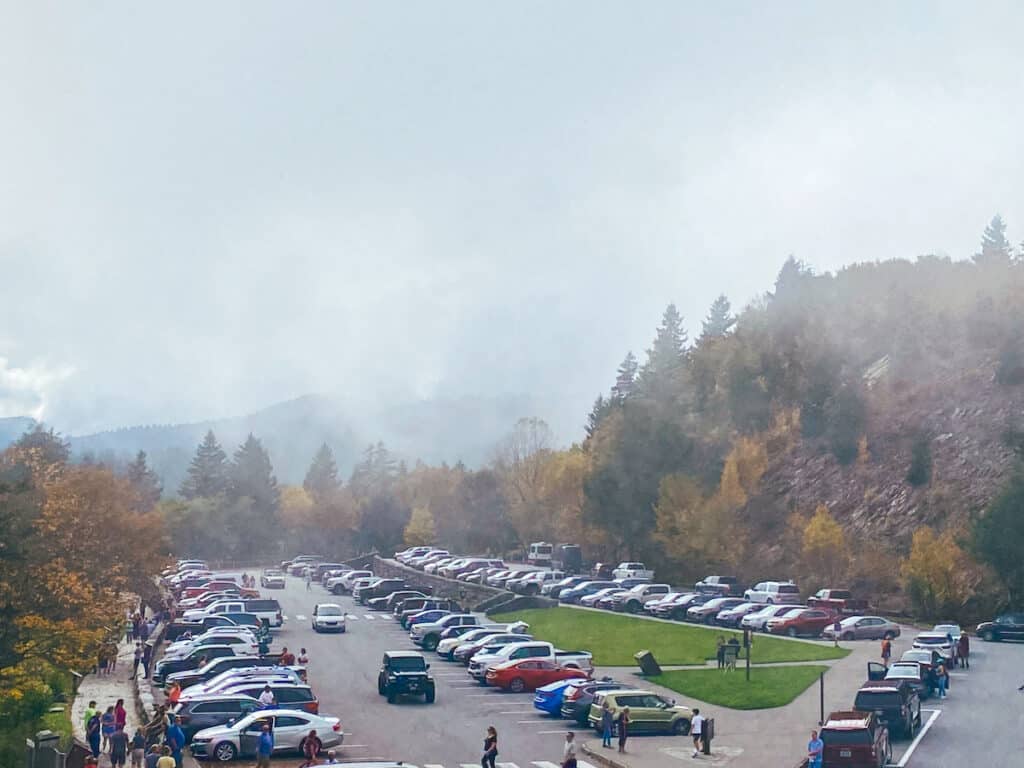
Is Great Smoky Mountains Dog Friendly?
Great Smoky Mountains is only semi pet friendly. Pets are allowed in campgrounds and picnic areas, and along 2 short walking paths – the Gatlinburg Trail and Oconaluftee River Trail. Pets are also allowed anywhere your vehicle can go, such as roadside pull-offs and sidewalks.
Pets are not allowed on other trails and must be leashed at all times.
How Many Days Should I Spend in Great Smoky Mountains?
Wondering how many days to spend on your Great Smoky Mountains itinerary?
If you are short on time, 2 to 3 days is enough to explore the highlights of Great Smoky Mountains National Park. However, if you have more time, there are virtually endless opportunities for hiking, wildlife viewing, and scenic drives in this beautiful park.
Thanks to its convenient location and tons of things to do, the Smokies are one of those Parks people return to again and again.
Want to learn more about planning an epic National Parks trip? Grab my free Ultimate National Parks Planning Guide, including 70+ pages of National Park packing checklists, planning tips, and everything you need to know to start planning a trip to all 63 National Parks!
What is the Best Times to Visit The Smokies?
The best time to visit Great Smoky Mountains is in the Spring or Fall, when there are fewer crowds than summer.
Summer in the Smokies brings heat, humidity, and lots of crowds. Trailhead parking lots and often fill by early morning, and scenic drives like Cades Cove can be bumper to bumper in the afternoon.
To avoid the worst of the crowds, avoid visiting during weekdays and holidays. For popular trails, like Clingmans Dome, Alum Cave, or Laurel Falls start hiking before 8AM (or earlier) or after 6PM, when most visitors have left the park.
In winter, most facilities in the park remain open year-round, except for some campgrounds and historic structures. The primary roads through the park – Newfound Gap Road, Cades Cove Loop, and Little River Road are open year-round. Clingman’s Dome Road and Roaring Fork Motor Nature Trail close in the winter. Check current conditions for park roads here.
Be sure to check park conditions before heading out in winter, and bring proper winter gear if you plan on hiking in snowy conditions.

The Great Smoky Mountains are Indigenous Land
The Smokies are ancestral lands of the Cherokee people, who called the place Shaconage or “place of blue smoke.” Most Cherokee Indians peoples were forcibly removed from the area in the 1800s during the march known as the “Trail of Tears.” Learn more about the Cherokee history in the Smokies here.
The Perfect Great Smoky Mountains 2 Day Itinerary
Are you ready to plan an unforgettable great smoky mountains weekend? Because of its easy accessibility, you’ll be surprised how much of this park you can see with 2 days in the Great Smoky Mountains.
This itinerary assumes you have 2 full days to spend inside the Park, and are staying on the Tennessee side.
Staying in North Carolina? If you are visiting from or staying in North Carolina, you will want to do the Day 1 itinerary in reverse, visiting the Oconaluftee Visitor’s Center first, before driving Newfound Gap Road west towards the Sugarlands Visitor’s Center.
2 Day Itinerary Great Smoky Mountains Map
This map shows all your stops on your 2 day Great Smoky Mountains itinerary.
How to Use This Map: Click the Icons on the map to see more information about each location. Click the star at the top of the map to add the map to your Google Maps account.
Want to take this itinerary to go? The 3 Day and 2 Day Great Smoky Mountains Itineraries include over 20 pages of daily itineraries, an in-depth Cades Cove guide, a detailed guide to the best hikes in Great Smoky Mountains, plus lodging and dining information, and tips for how to beat the crowds! Get your guide and learn more, here.

Great Smoky Mountains Itinerary Day 1
Your first day of your Great Smoky Mountains weekend is all about those iconic Smokies views. To maximize your time and avoid crowds, start as early as possible, ideally before 8am. Pack a lunch and enjoy a picnic on the go, or visit the many restaurants in Gatlinburg to relax before returning to the Park for must-see sunset.
If you only have one day in Great Smoky Mountains, this is also the perfect itinerary to visit the must-see areas of the park on limited time.

Hike Alum Cave Trail
5 miles round trip to Alum Cave Bluffs / Moderate / All Trails
10.9 miles round trip to Mt LeConte / Strenuous
Start your first day early in the Great Smoky Mountains with one of the most iconic hikes in the Park. The Alum Cave Trail ascends through forest and rocky cliffs to the summit of Mt LeConte.
The Trailhead is located on Newfound Gap Road, about 9 miles from the Sugarlands Visitor Center. Parking is really limited here and the spots fill up quickly, so try and get here as early as possible (before 8am).
The trail begins by following the Alum Cave creek through hardwood forest. Next, at 1.5 miles, hikers traverse through “Arch Rock” tunnel before ascending to Inspiration Point at 2 miles.
Most hikers turn around at Alum Cave Bluffs, about 2.3 miles from the trailhead.
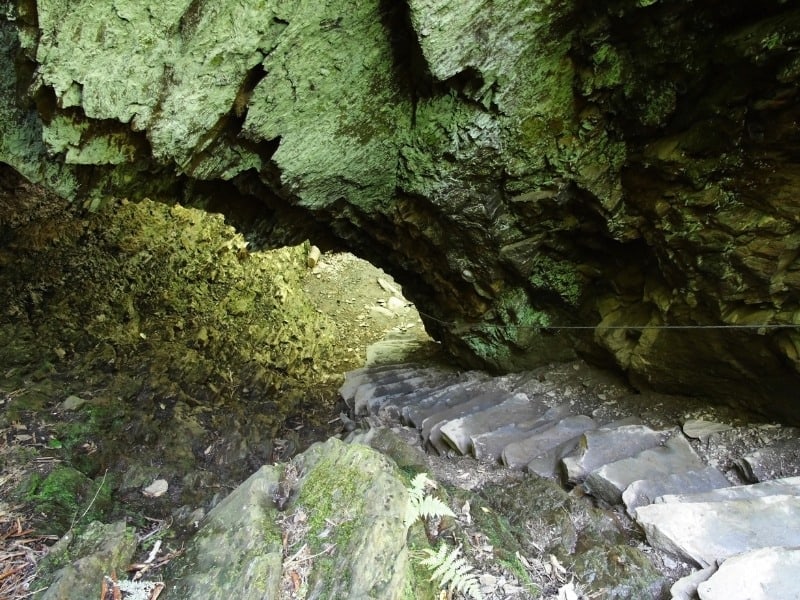
Looking for more of a challenge? Continue on Alum Cave Bluffs to ascend 6,575′ Mt LeConte. LeConte Lodge is located at the peak, the only hotel-style lodging located inside the Park. The Park uses llama trains to pack up supplies (and pack out trash) from the Lodge. If you’re lucky you might spot them on their weekly trek!
We weren’t lucky enough to see llamas on our trip, but fingers crossed we catch them next time!
Optional: Stop by the Sugarlands Visitor’s Center
After your hike, you can backtrack slightly to stop at the Sugarlands Visitor Center.
I’ll admit, this stop is never optional in my book, mostly because I’m a huge museum geek, and need to get my Passport stamp.
The Visitor Center is also an important stop to collect maps and ask advice from Park Rangers about trail conditions, parking availability, weather, and any other important information you’ll need before heading out.
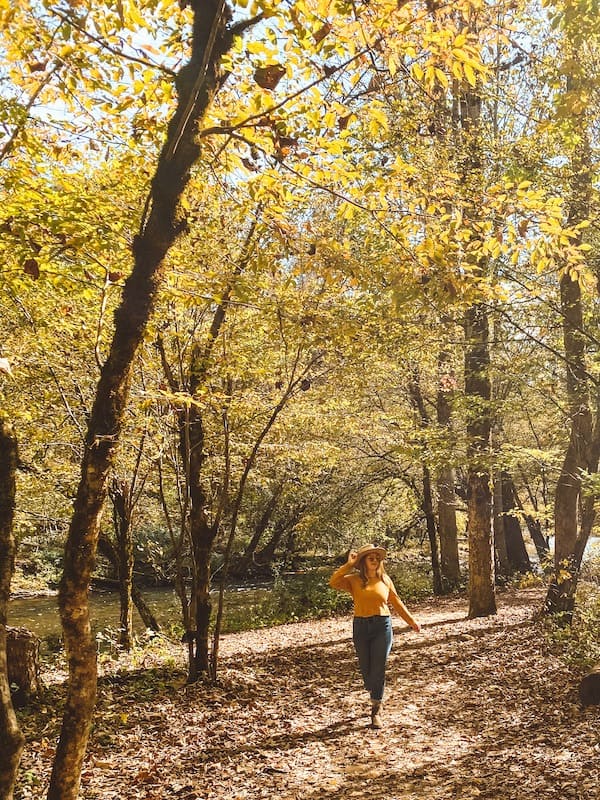
If you’re driving from the Tennessee towns of Gatlinburg or Pigeon Forge, your first stop is at the Sugarlands Visitor’s Center. If entering from Cherkoee, North Carolina, you will start at the Oconaluftee Visitor’s Center.
Both Visitor’s Centers have a small gift shop to stock up on your stickers, mugs, magnets and of course National Park Passport Stamps.
Stamps, stickers and journals are the perfect way to document your National Park Travels. I collect all my stamps and memories in my official Passport stamp collection book.
Drive Newfound Gap Road

Once you have your maps, stickers, and stamps from the Visitor’s Center, return to US 441 South, known as Newfound Gap Road. This highway runs through the heart of Park from Tennessee to the town of Cherokee, North Carolina.
Take your time on this 33 mile scenic road, and savor those incredible views at every turn. The road ascends nearly 3,000 feet in elevation to Newfound Gap (5,046′), the lowest driveable pass through the Smoky Mountains. Don’t forget to bring a jacket! Temperatures are often 10 degrees cooler at the high elevation passes compared to nearby Gatlinburg.

Must See Stops on Newfound Gap Road
Campbell Overlook: Scenic vistas of the Smokies, approximately 2 miles south of the Sugarlands Visitor Center.
Chimneys Picnic Area: If you’re traveling around lunchtime, the Chimneys Picnic Area, about 5 miles south of Sugarlands is the perfect spot to relax and refuel.
Chimney Tops Overlook: Just past the Picnic Area, this turnoff has views of the iconic “Chimney Tops” formations soaring 2,000 feet overhead.
Morton Overlook: Beautiful at any time of day, Morton Overlook is a popular spot for sunset.
Newfound Gap: At 5,046 feet in elevation, Newfound Gap straddles the state line between Tennessee and North Carolina. The Appalachian Trail runs right through the overlook as hikers descend from Clingmans Dome.
Note the turnoff for Clingmans Dome Road here. You’ll be coming back this way for the hike to Andrews Bald and Clingmans Dome for sunset. If you don’t have time to drive all the way to Oconaluftee, Newfound Gap makes a good spot to turn around, or head straight for Clingmans Dome parking.
If you have time, continue south on Newfound Gap Road towards Mingus Mill and the Oconaluftee Visitor Center.
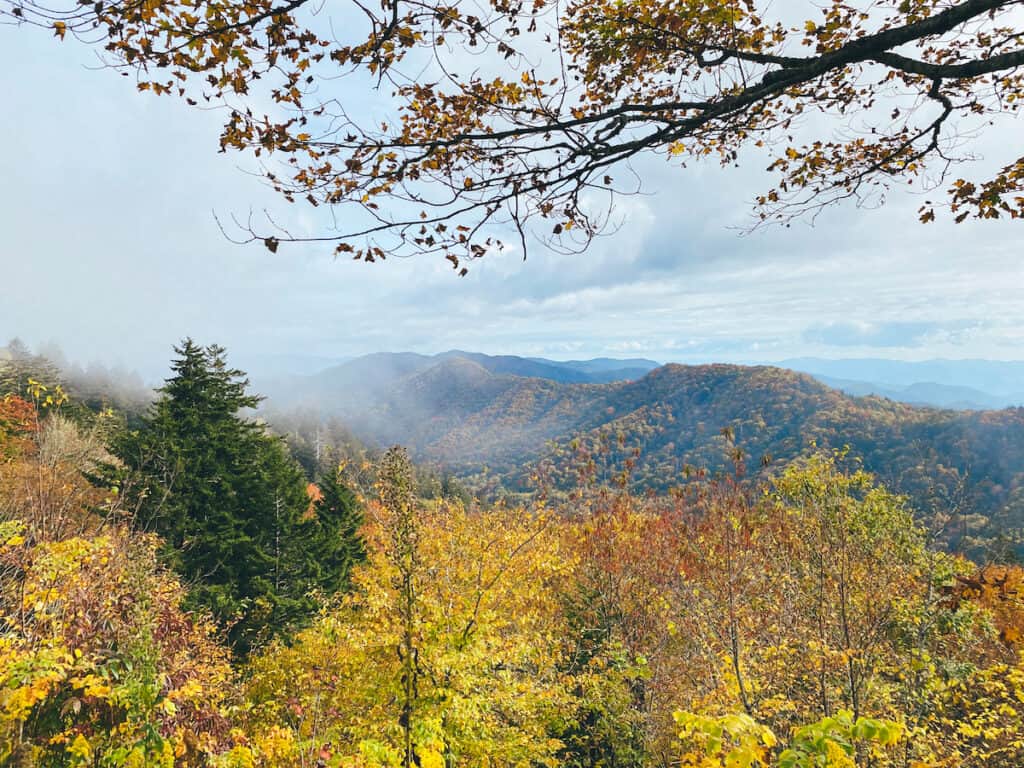
Mingus Mill: This historic grist mill, built in 1886, is located about 2 miles north of the Oconaluftee Visitor’s Center. Rangers operate the mill and give demonstrations to visitors March through November. If you plan on driving Cades Cove tomorrow, you can skip the Mill. Otherwise, the Mill is a great introduction to the historic buildings preserved throughout the Park.
Oconaluftee Visitor Center & Mountain Farm Museum
At the southern end of Newfound Gap Road lies the Oconaluftee Visitor’s Center and the town of Cherokee, North Carolina. The Oconaluftee Center includes exhibits about the Cherokee and later European settlers who have made the region home for hundreds of years.
The Mountain Farm Museum next to the visitor center is a huge interactive museum of preserved pioneer farm structures, including farmhouse, barn, and working blacksmith shop. Look closely and you can see the chickens that still call this farm home.
Keep your eye’s open for the herds of Elk that make this area home, especially in Fall.
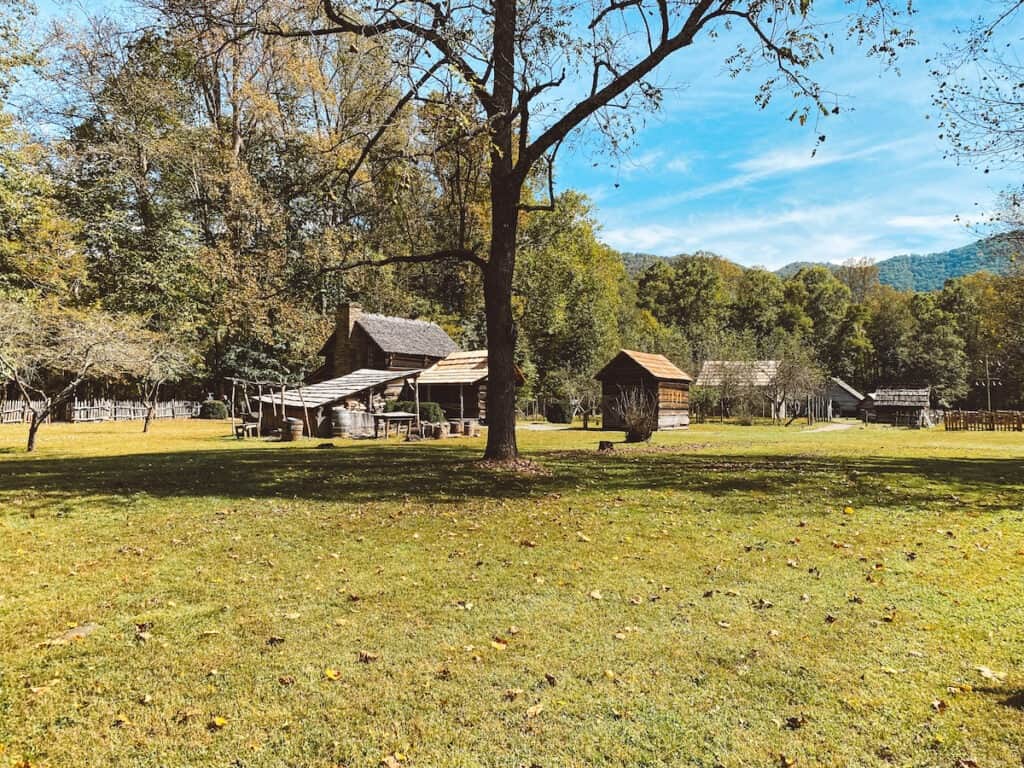
Optional: Hike to Andrew’s Bald
3.6 Miles / Moderate / 875 feet elevation gain / AllTrails
After stretching your legs inside the Center, return to your car and head north on Newfound Gap Road, retracing your route to Clingmans Dome Road, across the highway from the Newfound Gap Overlook you visited earlier.
The road climbs and ends at the Clingmans Dome parking lot. Warning, parking here can be a bit of nightmare during the summer. Be patient, and try and visit later in the afternoon, after 4pm, when many visitors start to leave the Park for the day.
If you have the time, Andrews Bald is the perfect companion to a sunset on Clingmans Dome. The 3.6 moderately difficult hike leads to one of the many “balds” in the Smokies, so called because these mountaintops are not covered by trees, but grass, rhododendron, and laurel.
From the Clingmans Dome parking lot, set out on the paved road towards Clingmans Dome. Shortly after the Park’s large interpretive signs, less than 0.1 miles from the parking lot, you will see a small trail and sign and on your left for “Forney Ridge Trail” to Andrews Bald.
Follow the Forney Ridge Trail as it descends for the first 1.1 miles through forest. Continue to follow signs for Andrews Bald at all trail junctions. The trail then heads uphill to Andrews Bald, with panoramic views of the surrounding mountains. The trail continues past the Bald, but turn around after you’ve soaked in the view and return the way you came, following signs for Clingmans Dome parking.
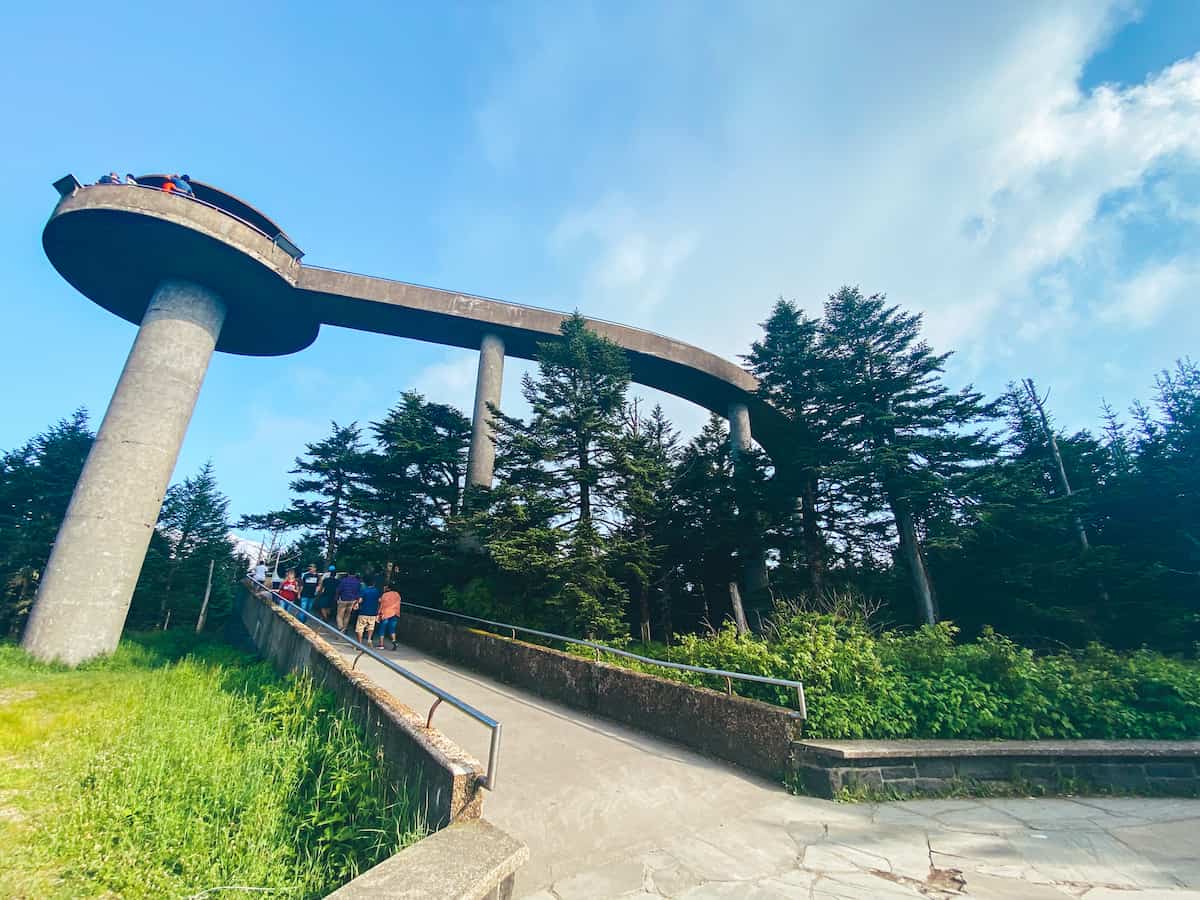
Sunset at Clingmans Dome
If you skipped hiking Andrew’s Bald, you’ll return to Newfound Gap Road and retrace your drive back towards Gatlinburg. At the crest of the highway, follow signs for Clingmans Dome Road. Clingmans Dome Road is across from the Newfound Gap Overlook you visited earlier.
The road climbs and ends at the Clingmans Dome parking lot. From here you can hike the steep 1 mile round-trip trail to the Observation Tower.
Observation Tower Trail
1 Mile / Easy / Not Wheelchair Accessible Due to Steep Grade / All Trails
At 6,643 feet, Clingmans Dome is the highest point in the Smoky Mountains. The Appalachian Trail crosses at the base of the observation tower, and is the highest point on the AT. At the summit of the Dome, the 45 foot high Clingman’s Dome Observation Tower provides 360 degree views of the surrounding mountains.
The area is subject to clouds and stormy conditions, even in the summer. Make sure to check weather conditions at the Dome before committing to your hike. Arrive early and expect big crowds at the Observation Tower.
From the Clingmans Dome parking lot, follow the paved trail to the Observation Tower. The trail is paved, steep, and usually crowded. If you aren’t used to hiking at higher elevations, take you time and rest on the many benches on the side of the trail.
At 0.5 miles, the path intersects with the Appalachian Trail before reaching the base of the Observation Tower. Use the 375 foot circular ramp to access the observation deck at the top of the Tower for 360 degree views of the Park.

Want to take this itinerary to go? The 3 Day and 2 Day Great Smoky Mountains Itineraries include over 20 pages of daily itineraries, an in-depth Cades Cove guide, a detailed guide to the best hikes in Great Smoky Mountains, plus lodging and dining information, and tips for how to beat the crowds! Get your guide and learn more, here.

Great Smoky Mountains Itinerary Day 2: Cades Cove & Laurel Falls
Day 2 of your 2 day itinerary in the Smoky Mountains is the perfect opportunity to explore more of the Park’s scenic drives and historic structures.
Cades Cove Loop Road Scenic Drive
Cades Cove is a broad valley surrounded by Smoky Mountains on all sides. The Cades Cove Loop Road is an 11 mile scenic tour of the many historic structures and sights of the Cove, and one of the most popular spots in Great Smoky Mountains Park.

Cades Cove Loop Road is vehicle free, every Wednesday, May 5 through September 1. During these times, the loop is only open to hikers and bicycles to enjoy.
The Cades Cove Loop road is an 11 mile scenic drive through the broad Cades Cove valley. The area was first settled by Europeans in the early 1800s, and many historic structures have been preserved here from this era.
While driving the Loop Road theoretically can take less than an hour, its really an all-day event. Plan to get out of your car and explore the historic buildings and enjoy a short hike or two.
Some of the must-see stops in Cades Cove are:
- John Oliver Cabin
- Primitive Baptist Church, Methodist Church, and Missionary Baptist Church
- Elijah Oliver Place
- Cades Cove Visitor Center and Historic Grist Mill
- Abrams Falls
- Whitehead Cabin
- Dan Lawson Place
- Tipton Oliver House
- Carter Shields Cabin
The Visitor Center, located about halfway around the loop is a good spot to stretch your legs and enjoy a picnic.
The Historic Grist Mill next door is a working water-powered mill that still operates to this day! You can learn all about farming history in this super remote valley, and take home a bag of mill-ground cornmeal from the giftshop!
There are plenty of homesteads and cabins around the loop, but our favorite was the Whitehead Cabin, located off the main road on Forge Creek Road, just past the visitor center. Since this spot isn’t on the main Cades Cove Loop road, its not as crowded and you might actually get a moment to yourself!

For a complete guide to visiting Cades Cove, including how to get there, what to see, and tips for beating the crowds, check out my new guide, 17 Best Things to Do in Cades Cove.
Hike to Laurel Falls
2.4 Miles / Easy / Not wheelchair or stroller accessible / AllTrails
Once you’ve had your fill of grist mills and historic log homes, exit Cades Cove via Laurel Creek Road and drive back towards the Sugarlands Visitor’s Center. Laurel Creek Road becomes Fighting Creek Gap Road at the intersection of Elkmont Road, about 40 minutes from Cades Cove.
Just past Elkmont Road, park at the designated parking lot for Laurel Falls. This is one of the most popular things to do in Great Smoky Mountains National Park. The parking lot is frequently full during summers and weekends. Overflow parking lots are located further down Fighting Creek road. Park and walk to the trailhead, following the signs.
The 80 foot high Laurel Falls are named for the mountain laurel that blooms here in Spring. The trail is well marked and mostly paved. However, strollers and wheelchairs are not recommended, as the old pavement is cracked and crumbling in many places.

From the Laurel Falls trailhead, the trail climbs gently through verdant forest. Keep your eyes open for black bears, especially early in the morning, as there have been sightings on the trail. The Falls are divided into an upper and lower section divided by a wooden bridge. Take care on slippery rocks and watch small children around steep drop offs.
Bring plenty of water, especially on humid summer days. This hike can be done with a sturdy pair of sneakers or hiking boots.
Return to your car and head back to your lodging.
Grab dinner in Gatlinburg after a busy 2 days in Great Smoky Mountains. Our favorite restaurant was The Park Grill in Gatlinburg. For a more upscale option, check out The Appalachian in nearby Sevierville. For pizza and brews, check out Gatlinburg Brewing Company.
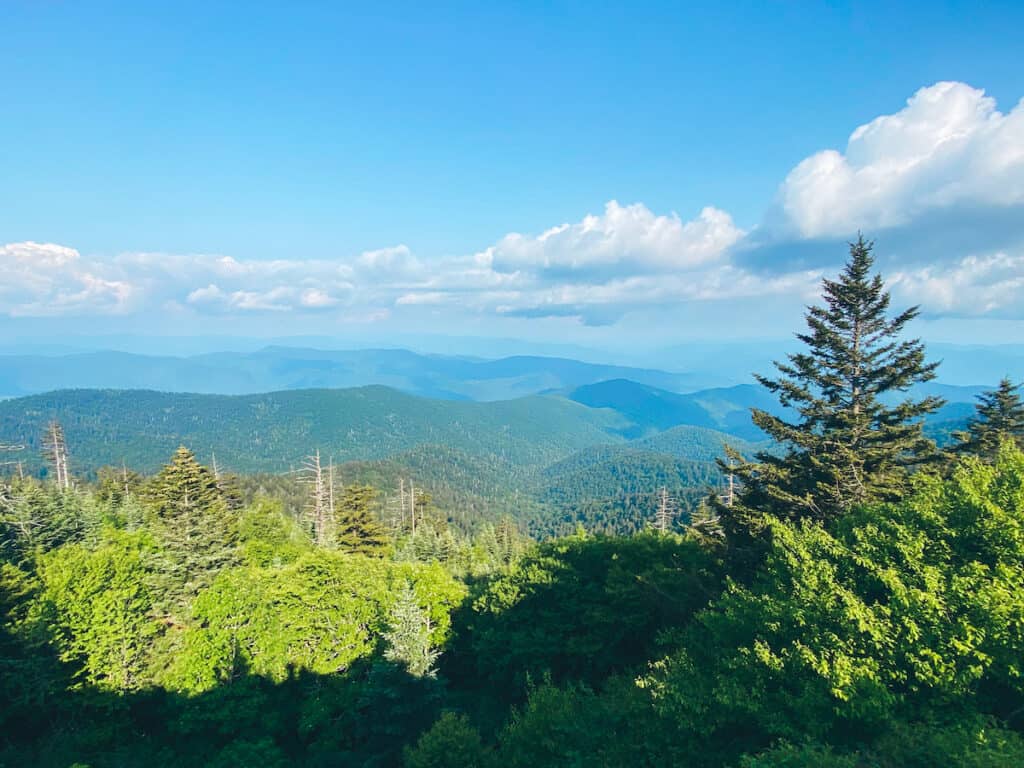
More Things to Do in Great Smoky Mountains National Park
Have more than 2 Days in the Park? Want to try something different? Check out these other things to do in Great Smoky Mountains National Park.
Roaring Fork Motor Nature Trail
Located a short distance from Gatlinburg, the Roaring Fork Motor Nature trail is a 5.5 winding, scenic drive through hardwood forests and historic cabins and grist mills.
The Motor Nature Trail is a great alternative if you don’t want to commit to the longer and more crowded Cades Cove Loop.
There are tons of great hikes that leave from the Roaring Fork Motor trail (or nearby) including Rainbow Falls (5 Miles / Moderate) and Grotto Falls via Trillium Gap Trail (2.6 Miles / Moderate).
Learn more about the Roaring Fork Motor Nature Trail here.
Hike Charlies Bunion via Appalachian Trail
8 Miles / Difficult / 1,600′ Gain / AllTrails
Take a day hike on the world-famous Appalachian Trail, which runs 2,190 milesand through the Smokies on its way from Georgia to Maine.
This moderate hike traverses multiple peaks on its way to Charlie’s Bunion, a large outcropping with classic smoky mountain views. The Trail leaves from Newfound Gap where the Appalachian Trail crosses with Newfound Gap Road.
This hike takes about 4 hours round trip. Make sure to bring plenty of water, snacks, and appropriate hiking gear.
Hike or Backpack Gregory Bald
11.6 Miles / Strenuous / 3,350′ Gain / AllTrails
A strenuous day hike that is also popular for backpacking. To get to this hike, you’ll need to drive on the unpaved Forge Creek Road (most passenger cars can make it, just drive carefully). Forge Creek road closes in winter, so plan to do this hike March – November.
After a steady climb for 5.5 miles, the summit has stunning views of the surrounding Smokies and Cades Cove.

Where to Stay Near Great Smoky Mountains National Park
There are plenty of options for lodging in and around Great Smoky Mountains National Park. Stay in one of the popular 10 frontcountry campgrounds inside the National Park, or opt for hotels, motels, and rental cabin accommodations in the towns nearby.
Check out more lodging options near Great Smoky Mountains on Tripadvisor.
Lodging Inside Great Smoky Mountains.
Lodging options inside Great Smoky Mountains are limited. There is only one hotel inside the park, Le Conte Lodge, which is accessible only by foot via a 5.5mile hike. Reservations for Le Conte fill many months in advance, but cancellations do occur if your plans are flexible.
There are 10 frontcountry campgrounds that are accessible by car inside the park. Campgrounds have cold running water and flush toilets, and campsites have fire rings and picnic tables.
Backcountry camping for backpackers and Appalachian Trail hikers is available at designated primitive campsites and shelters. All backcountry campers must have a permit before setting out. Backcountry permit information is available on the Park’s website.

Lodging Outside the Park
If you only have two days or less to visit Great Smoky Mountains, I recommend staying in the towns of Pigeon Forge or Gatlinburg on the Tennessee side of the Park. These towns are located just outside the Sugarlands entrance and Visitor Center, and most hotels are within 20 minutes of the park.
There are a variety of chain hotels like Fairfield Inn & Suites by Marriott and family-friendly mountain resorts like the Greystone Lodge on the River. Personally, we love to book a vacation home rental with a kitchen – and there are tons of cabins and mountain homes to book nearby.
>> Click here to book hotels in Gatlinburg, Tennessee
Between the neon lights, go-carts, and endless fast food options, Pigeon Forge and Gatlinburg can feel a lot like Las Vegas in the woods (or “Appalachian Disneyland” as my husband said). However, the direct access to the park, plenty of lodging and food options, and easy access to the highway make it the easy choice for a short visit.
What to Pack for Your 2 Days in Great Smoky Mountains
Hiking Backpack: Your backpack should be lightweight with enough support to carry a full day’s worth of supplies without hurting your back and shoulders.I use the Osprey Sirrus 24 daypack which has plenty of storage and space for a 2L hydration reservoir.
Rain Jacket: Rain is common in the Smokies in all seasons. The North Face Venture 2 jacket is waterproof, windproof, and packable.
Hiking Shoes and Socks: Most trails on this Great Smoky Mountains Itinerary can be done with a good pair of sneakers, but I always recommend using hiking boots or hiking shoes for the best comfort and safety. I swear by the Merrell Moab 2, available both as a hiking shoe and hiking boot. If you’re looking to upgrade to a more hardcore option, I love my Salomon X Ultra 3 Mid boot.
Remember, the best hiking shoes are only as good as the socks you wear. Darn Tough socks come in a variety of fun colors and have never let me down! Trust me, these bad boys are worth it to avoid blisters and comfortably break in any boot.
Bug spray: As someone who has some kind of invisible “All You Can Eat Buffet” sign above my head that only mosquitos can see, I use repellant sprays with DEET or Picaridin.Many other hikers prefer a DEET-free spray made with essential oils such as lemon and eucalyptus.
Hiking Tops: Look for tops that are moisture wicking and quick drying.Try the Patagonia Capilene Cool tanks and shirts, or check out more women’s performance tops on Backcountry.com.
Hiking Pants: For long pants, check out the Columbia Saturday Trail Pant. If you’re more a leggings gal, I wore my trusty Girlfriend Collective High-Rise Pocket Legging.
Water: Plan to bring 1/2 liter of water for every hour of hiking.
Explore More National Parks
Get the Ultimate National Parks Planning Guide (for free!) sent to your inbox, full of important planning information, printable packing lists, and the best things to do in all 63 National Parks.
Big Bend: Epic Big Bend Itinerary Guide
Bryce Canyon: One Epic Day in Bryce Canyon National Park
Cuyahoga Valley: 17 Best Things to Do in Cuyahoga Valley National Park
Great Smoky Mountains: The Ultimate Great Smoky Mountains Itinerary in 2 Days
Joshua Tree: The Perfect Day Trip to Joshua Tree National Park
New River Gorge: The Best Hikes in New River Gorge National Park
Yosemite: Epic Yosemite 2 Day Itinerary – How to Spend 2 Perfect Days in Yosemite
Zion: Ultimate 2 Days in Zion National Park Itinerary






